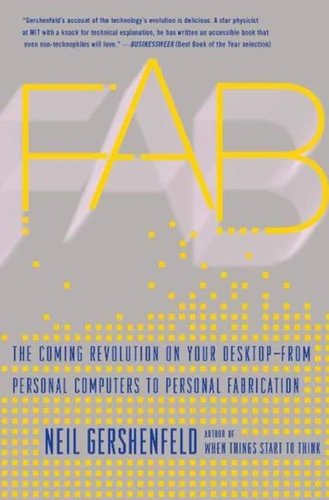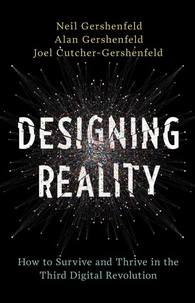Fab. The Coming Revolution on Your Desktop - - from Personal Computers to Personal Fabrication
Par :Formats :
Disponible dans votre compte client Decitre ou Furet du Nord dès validation de votre commande. Le format ePub protégé est :
- Compatible avec une lecture sur My Vivlio (smartphone, tablette, ordinateur)
- Compatible avec une lecture sur liseuses Vivlio
- Pour les liseuses autres que Vivlio, vous devez utiliser le logiciel Adobe Digital Edition. Non compatible avec la lecture sur les liseuses Kindle, Remarkable et Sony
- Non compatible avec un achat hors France métropolitaine
 , qui est-ce ?
, qui est-ce ?Notre partenaire de plateforme de lecture numérique où vous retrouverez l'ensemble de vos ebooks gratuitement
Pour en savoir plus sur nos ebooks, consultez notre aide en ligne ici
- Nombre de pages288
- FormatePub
- ISBN978-0-7867-2204-4
- EAN9780786722044
- Date de parution30/07/2008
- Protection num.Adobe DRM
- Infos supplémentairesepub
- ÉditeurBasic Books
Résumé
What if you could someday put the manufacturing power of an automobile plant on your desktop? It may sound far-fetched-but then, thirty years ago, the notion of "personal computers" in every home sounded like science fiction. According to Neil Gershenfeld, the renowned MIT scientist and inventor, the next big thing is personal fabrication -the ability to design and produce your own products, in your own home, with a machine that combines consumer electronics with industrial tools.
Personal fabricators (PF's) are about to revolutionize the world just as personal computers did a generation ago. PF's will bring the programmability of the digital world to the rest of the world, by being able to make almost anything-including new personal fabricators. In FAB , Gershenfeld describes how personal fabrication is possible today, and how it is meeting local needs with locally developed solutions.
He and his colleagues have created "fab labs" around the world, which, in his words, can be interpreted to mean "a lab for fabrication, or simply a fabulous laboratory." Using the machines in one of these labs, children in inner-city Boston have made saleable jewelry from scrap material. Villagers in India used their lab to develop devices for monitoring food safety and agricultural engine efficiency.
Herders in the Lyngen Alps of northern Norway are developing wireless networks and animal tags so that their data can be as nomadic as their animals. And students at MIT have made everything from a defensive dress that protects its wearer's personal space to an alarm clock that must be wrestled into silence. These experiments are the vanguard of a new science and a new era-an era of "post-digital literacy" in which we will be as familiar with digital fabrication as we are with the of information processing.
In this groundbreaking book, the scientist pioneering the revolution in personal fabrication reveals exactly what is being done, and how. The technology of FAB will allow people to create the objects they desire, and the kind of world they want to live in.
Personal fabricators (PF's) are about to revolutionize the world just as personal computers did a generation ago. PF's will bring the programmability of the digital world to the rest of the world, by being able to make almost anything-including new personal fabricators. In FAB , Gershenfeld describes how personal fabrication is possible today, and how it is meeting local needs with locally developed solutions.
He and his colleagues have created "fab labs" around the world, which, in his words, can be interpreted to mean "a lab for fabrication, or simply a fabulous laboratory." Using the machines in one of these labs, children in inner-city Boston have made saleable jewelry from scrap material. Villagers in India used their lab to develop devices for monitoring food safety and agricultural engine efficiency.
Herders in the Lyngen Alps of northern Norway are developing wireless networks and animal tags so that their data can be as nomadic as their animals. And students at MIT have made everything from a defensive dress that protects its wearer's personal space to an alarm clock that must be wrestled into silence. These experiments are the vanguard of a new science and a new era-an era of "post-digital literacy" in which we will be as familiar with digital fabrication as we are with the of information processing.
In this groundbreaking book, the scientist pioneering the revolution in personal fabrication reveals exactly what is being done, and how. The technology of FAB will allow people to create the objects they desire, and the kind of world they want to live in.
What if you could someday put the manufacturing power of an automobile plant on your desktop? It may sound far-fetched-but then, thirty years ago, the notion of "personal computers" in every home sounded like science fiction. According to Neil Gershenfeld, the renowned MIT scientist and inventor, the next big thing is personal fabrication -the ability to design and produce your own products, in your own home, with a machine that combines consumer electronics with industrial tools.
Personal fabricators (PF's) are about to revolutionize the world just as personal computers did a generation ago. PF's will bring the programmability of the digital world to the rest of the world, by being able to make almost anything-including new personal fabricators. In FAB , Gershenfeld describes how personal fabrication is possible today, and how it is meeting local needs with locally developed solutions.
He and his colleagues have created "fab labs" around the world, which, in his words, can be interpreted to mean "a lab for fabrication, or simply a fabulous laboratory." Using the machines in one of these labs, children in inner-city Boston have made saleable jewelry from scrap material. Villagers in India used their lab to develop devices for monitoring food safety and agricultural engine efficiency.
Herders in the Lyngen Alps of northern Norway are developing wireless networks and animal tags so that their data can be as nomadic as their animals. And students at MIT have made everything from a defensive dress that protects its wearer's personal space to an alarm clock that must be wrestled into silence. These experiments are the vanguard of a new science and a new era-an era of "post-digital literacy" in which we will be as familiar with digital fabrication as we are with the of information processing.
In this groundbreaking book, the scientist pioneering the revolution in personal fabrication reveals exactly what is being done, and how. The technology of FAB will allow people to create the objects they desire, and the kind of world they want to live in.
Personal fabricators (PF's) are about to revolutionize the world just as personal computers did a generation ago. PF's will bring the programmability of the digital world to the rest of the world, by being able to make almost anything-including new personal fabricators. In FAB , Gershenfeld describes how personal fabrication is possible today, and how it is meeting local needs with locally developed solutions.
He and his colleagues have created "fab labs" around the world, which, in his words, can be interpreted to mean "a lab for fabrication, or simply a fabulous laboratory." Using the machines in one of these labs, children in inner-city Boston have made saleable jewelry from scrap material. Villagers in India used their lab to develop devices for monitoring food safety and agricultural engine efficiency.
Herders in the Lyngen Alps of northern Norway are developing wireless networks and animal tags so that their data can be as nomadic as their animals. And students at MIT have made everything from a defensive dress that protects its wearer's personal space to an alarm clock that must be wrestled into silence. These experiments are the vanguard of a new science and a new era-an era of "post-digital literacy" in which we will be as familiar with digital fabrication as we are with the of information processing.
In this groundbreaking book, the scientist pioneering the revolution in personal fabrication reveals exactly what is being done, and how. The technology of FAB will allow people to create the objects they desire, and the kind of world they want to live in.







